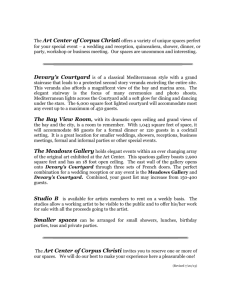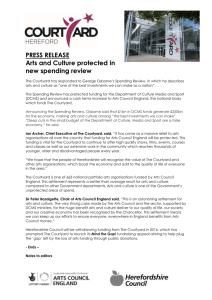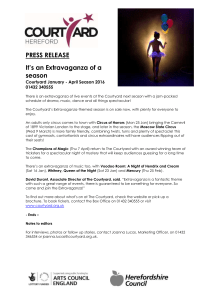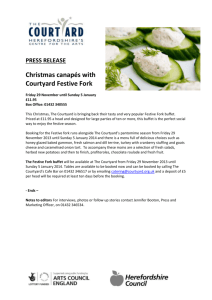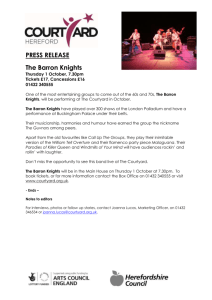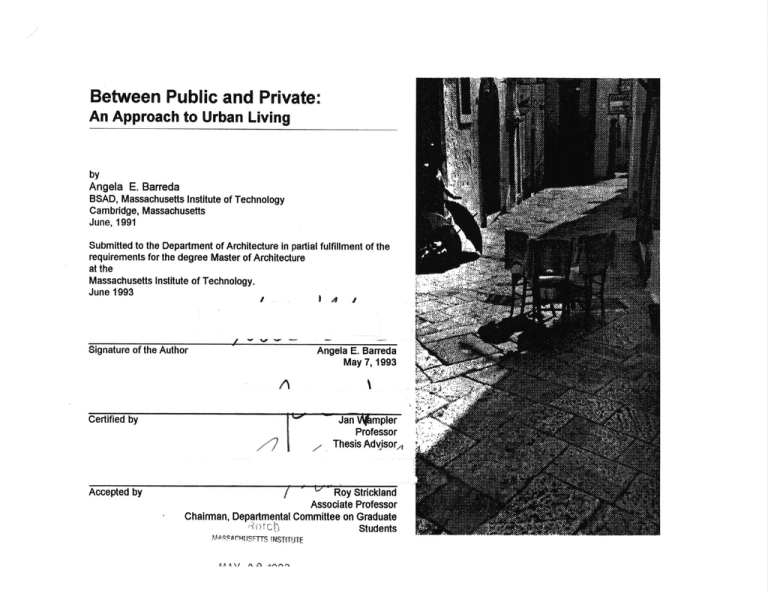
Between Public and Private:
An Approach to Urban Living
by
Angela E. Barreda
BSAD, Massachusetts Institute of Technology
Cambridge, Massachusetts
June, 1991
Submitted to the Department of Architecture in partial fulfillment of the
requirements for the degree Master of Architecture
at the
Massachusetts Institute of Technology.
June 1993
Signature of the Author
Angela E. Barreda
May 7, 1993
Certified by
Jan Vbmpler
Professor
Thesis AdvisorA
Accepted by
/-* Roy Strickland
Associate Professor
Chairman, Departmental Committee on Graduate
COI
MA%'Af'4IjSFTTS
INSTITUTE
MAY 02 1993
Students
Title page: Street scene at Martina Franca (from Rudofsky, 1964)
2
CAngela E. Barreda 1993. All rights reserved.
The author hereby grants to M.I.T. permission to reproduce and to distribute
publicly copies of this thesis document in whole or in Part
Thank you...
Jan Wampler
for all the time and support,
Renee Chow and Shun Kanda for
taking the time to be critics.
Thank you...
Maryellen,
for putting up with the "middle aged
german woman",
Sid,
for the company, moral support, reality
checks, career counseling, the dinner
club, ...
the best thesis TA.
Edward Hopper, "Nighthawks" (from John Canaday,
1980)
4
Table of Contents
5
Acknowledgements
Table of Contents
Abstract
Between Public and Private
Public Space in the City
The Proposal
Site
Program
Design
Betweens
Street Edge
Courtyard Edge
Courtyard
Entry
Linkages
Stoop
Kitchen
Window Seat
Balconies and Terraces
Conclusion
Appendix
Bibliography
3
5
7
9
11
16
22
24
34
44
50
56
68
70
72
74
76
79
84
Howard Norton Cook,
"ExteriorView of the House of Weyhe"
6
Between Public and Private: An Approach to Urban Living
by Angela Barreda
on May 7, 1993
Architecture
of
Submitted to the Department
for
requirements
the
of
in partial fulfillment
Architecture.
of
Master
of
the Degree
Abstract
7
The city provides work as well as housing to a great number of individuals, couples and families
who are dependent on the urban environment for employment or education. Unfortunately urban living
in today's cities has become disconnected. The dwelling is not a part of the surrounding community but
rather a island in an anonymous environment. As a result, urban communities have deteriorated and
become a transient location for people who move on after a short period of time. The community no
longer has the commonality of understanding needed for a functioning living environment.
To revitalize the city and make it more attractive to a larger variety of people there needs to be a
more connected community which provides opportunities to encounter the life and activity in the public
realm. There also needs to be a more secluded realm which makes life in the city not only a public
experience but also provides the opportunity to retreat from it.
This thesis concentrates on creating the connection between the public and the private realm. In
addition it addresses the connection to a community courtyard within an urban city block. Exploring
these issues in architectural form is an attempt to address the problem. The thesis provides a proposal
for an alternative urban living environment which does not represent a complete solution but an
investigation of the elements crucial to an urban living environment.
Thesis Supervisor: Jan Wampler
Title: Professor of Architecture
Between Public and Private
Life in an urban environment involves more than
housing. The housing unit itself is a subordinate
element. Urban Living is about occupying the city and
the relationship between public and private space. This
includes movement and connection. Urban living in this
thesis focuses primarily on the connection between the
private living spaces and the most public urban space,
the street and the most public community space, the
courtyard. Between public and private is defined not
only by the physical spaces between but also visual
connections and movement from one condition to
another. It becomes a "condition" which changes with
scale and specific relationship. What might be public
compared to one space may become private compared
to another. It exists on all levels from the urban scale to
details such as doors and windows. "Between"
Street scene at Martina Franca
(from Rudofsky, 1964)
represents the overlap of two conditions and influences
them by establishing their relationship. This may occur
by providing a zone which can be used by both sides in
different ways.
Osaka, Japan (from Rudofsky, 1964)
Cb
C4b
~lx
0#
C*
C'*,
Q0
*
.
-
Public Space in the City
Throughout history public space has been a means
of communication between members of society. The
public plaza and the market place both serve the need
to gather, to celebrate or to purchase goods
However, public space is not only the formal square or
market . It includes foremost the street which is primarily
perceived as a means of transportation but actually
serves as a connector within society. The street reflects
all facets of society and situations. It is a place where
you meet people of your neighborhood by accident, not
by appointment. It isthe setting for serendipitous
interaction of people, a sequence of observing and
being observed . In essence it isthe instrument for
creating unpursued human interaction. In this role the
street is vital to the existence of urban life.
Before the age of the automobile and the television
people were forced to use the street as a means of
participating in society as well as getting from one
Gustave Dor6, "ACity Thoroughfare"
(from Broadbent, 1990)
location to another. The form of transportation used to
Street vendor
in Ponce, Puerto Rico
be primarily on foot which is at considerably lower speed
than today's mass transit or the automobile and
therefore fostered more interaction. Unfortunately the
pedestrian in the street has been replaced by the
automobile. Activities such as shopping are not done at
smaller community stores but at supermarkets, where
buying in bulk requires a car and is disconnected from
the neighborhood. Asimilar condition of this kind isthe
mall, a replacement of the shopping street. It offers a
concentration of shops which is not readily available in
the city at such proximity and with controlled climate.
However, it is disjointed from the urban life by lacking
connection to a residential environment
The pedestrian walking in the street and being
exposed to others from different backgrounds is
disappearing. As a result communities are becoming
disconnected, through the lack of social interaction.
Via Saragozza, Bologna
Cathedral at Bologna (from Rudofsky, 1964)
The Proposal
15
.
The Site
b
The Site
17
Within this project the site plays a particular role in
that it provides a setting for an exploration rather than
the driving force which the design is derived with. To
explore the idea of urban living, a site which supported a
community was needed. The North End in Boston
provides such an urban community which includes a mix
of residential and commercial uses. The site is presently
a vacant half block used for parking. The other half
consists of typical North End four story brick town
houses. Typically these are built on at a 20 foot module.
Often the first floor is commercial use and the floors
above residential. Access is located along the party wall
of the house, which services all units within the building.
Buildings are typically row hoses facing the street at the
front and an alley in the back. They have flat roofs
which are used by the residents.
The North End provides a lot of accidental small
scale urban spaces such as openings between row
houses. They make for a richer environment by opening
Waited up window in the North
End, Boston
up a view into the spaces within the block and becoming
a small place of inhabitation along the path. However,
they are not used to their full extent. Most of them are
unclaimed alleys and leftover, unused spaces.
San Juan, Puerto Rico contains environments similar
to those in the North End on a similar scale. However
they are more often claimed by residents, which makes
them attractive to the pedestrian and enriches the
environment. Building on the existing conditions in the
Map of Boston
900
6
~
9,~
60
1
0
9)
toesu: ton!
o
~
'p
Os
60b
1
6
oo
6
'/
91
eo
80
:97
)9
seiis
d7,?,
:06
9)
o1E20I
0oo
104
13,614
40
P .;o6'
14,09 0
\89
/00\
\i
~4
CC
743
'
-.-
AN.
4
..
T!
170
ILc
-5
482
9.
669
V82
IlejI
-00
2
\
/)c
:1
/3
"'7
/
I-
NO71
S6IAR
~~R h
Map of the North End, Boston
North End and understanding references such as San
Juan, the proposal can maintain the scale and the
character of the site as well as provide a stronger
framework for the community.
Fire escape on a building on the site
San Juan, Puerto Rico
View into a courtyard
Guyama, Puerto Rico
Alley in the North End
Program
22
Program:
-
46 residential units
-
several existing shops
-
day care facilities
-
elderly housing
-
cafe /restaurant
-
laundry room
-
interior courtyard
-
public square adjacent to the cafe
The program does not necessarily include all uses, it
addresses the ones important to establishing the
Early model showing the party walls and balconies
projecting into the courtyard
communal framework.
To still provide a private environment but integrate
mixed use within the courtyard the whole project is
divided into two parts:
The residential, comprised mostly of duplexes and
the elderly housing grouped around one section of the
courtyard
The public, which mixes housing, laundry facilities,
commercial, day care and restaurant grouped around
the more public side of the courtyard.
Early model showing the
residential courtyard
Design
24
The mixing of uses provides for a more varied and
intermixed living environment. These uses can take
advantage of the courtyards in cases such as day care,
the laundry room or the cafe and therefore encourage
interaction.
In order to maintain the character of the
neighborhood and to create an urban edge to give the
street definition and enclosure, the edge of the block is
maintained on the original street pattern. At one corner it
opens up to create a public space with a visual link to
the courtyard . Directly adjacent to it isthe cafe which
would occupy part of it as an outdoor seating area
during the warmer seasons. The units are located in row
View from street
house like arrangements which are separated by party
walls and entry zones. Movement into the units occurs
from the street edge through these zones which also
engage the courtyard and allow views into it. Roof
terraces are located on the top of the buildings to
provide a different kind of outdoor space which
25
overlooks the street or the courtyard. The courtyard
itself is a controlled space which is physically only
accessible through the entry zone. It provides a
Early model exploring the massing on the site
controlled space available to the residents within the
block.
The larger elements which the design focuses on are
the edges which exist between public and private on the
site scale. Besides the overall design organization these
elements are the focus of this thesis and will be
described individually.
View of roof tops
26
ludy storsge
LI
commercia,
I,
2
Plan
8
1
Io
Modified Courtyard Edge
Existing Street Edge
Courtyard
Courtyard Edge
Street Edge
-
U
-
wm
S~~.
-
..
.
. .
28
living
service/access
cooking/eating
First Floor
living
service/access
cooking/eating
2
4
-S
*n
~
29
sleeping
service/access
sleeping
sleepin
serv ice/access
sleepin
2
4
3
Second Floor
em
p
i
~
s
en
a
a
30
living
service/access
cooking/eating
living
service/access
cooking/eating
I
2
Third Floor
4
saSs
e
~ga
.1 toe
Fourth Floor
eeMamwalleler
ter
asu
etwa
canais
Betweens
View from the street
33
Palladio's theatre uses the street as a permanent stage set
Teatro Olimpico, Vicenza (from Rudofsky, 1964)
The Street Edge
35
In a community the street is the center of public life.
It isthe fabric of the community. Neighbors meet, going
to work or shopping. It becomes the common ground
within the larger community.
The living unit can contribute to public life by
establishing a connection between its occupants and the
street. The formal interpretation of this connection is the
edge or enclosure which has to be permeable. Its
treatment is a critical factor in encouraging as well as
controlling the interaction between public and private.
In addition to being the public domain the space
above the street, next to the units on the upper floors,
also becomes visually inhabitable. It can be used by
adjacent units to visually extend the living space into the
street. By providing this option the quality of the living
space is increased.
Use along the edge is an important factor in the
interaction. The most public and active spaces within a
living unit are located at the street edge to develop
Street in Heidelberg lined with small
street cafes along the edge
II
animation along it and to foster connection. The kitchen
displays activity and is therefore more compatible with
the street. It also enables the closure to be more open
due to the fact that active areas do not require as much
control of privacy as other spaces.
The materials used for the closure represent different
degrees of privacy and flexibility. The edge directly
adjacent to the public sidewalk therefore uses a hard
tAl
Study
material such as concrete and stucco with openings
punched through it. When there is less need for privacy
the materials change to corrugated metal and glass
which allow for more openness and flexibility.
Inthe street elevation the enclosure is divided into
three zones which all relate to different zones within the
street.
The first floor responds to its proximity to the
sidewalk which is a highly public area. In order to create
interaction the enclosure is heavy with punched
openings and the same uses associated with them as on
37
upper floors. In addition the living unit is elevated two
feet above the sidewalk to separate the unit from the
sidewalk and to let the residents overlook the street
rather than be overlooked by it.
Section through street and
street edge
Inthe middle zone the unit is more open to the
street. It provides small balconies and engages the
space by projecting out into the street in form of a
window seat. Lighter materials such as corrugated metal
and glass are used. Similar to the lower floor there is
still some need for control of privacy due to the
narrowness of the street which brings the neighbor
across the street closer to the unit.
Elevation study
Finally the upper zone requires the least provisions
for privacy. It overlooks the street as well as the
neighbors across the street. This allows for more glass
and openness not permitted in the lower areas. The
balconies become larger due to the enclosure moving
Wiew onto the square
back, away from the edge.
Inall cases there are devices to control privacy and
light such as screens which slide open and shut to
facilitate the adjustment to more or less privacy.
Section through street edge
showing the kitchen sinks and
the window seats
Study models
40
Early elevation study
Section through courtyard
Street elevation
Street elevation
Balcony facing onto the courtyard in the "Casa Blanca",
in San Juan
Courtyard Edge
45
The Casa Blanca, Ponce de Leon's former
residence in San Juan, Puerto Rico includes aspace
which is part of the grounds and publicly accessible, but
is surrounded and enclosed by private houses which
make up its edge. For the residents of these adjacent
spaces the park is not directly accessible but still
becomes part of the usable space by extending into it
with balconies, windows and roof terraces. This
expansion of the living unit into the public space is a
controllable element which lets spaces be used in
different ways by different people at the same time.
The courtyard edge enables the units to visually
inhabit the courtyard but still maintain privacy. To
accomplish this the enclosure uses large glass doors
which open up to allow light, air, view and inhabitation
across it. There is a distinction vertically between
heavier and lighter enclosure responding to the need for
privacy. However it is not as distinctive as the street
edge due to the less public condition of the courtyard.
View into a courtyard inMilan, Italy
(fromZucchi, 1989)
On the first floor there is even a direct connection to the
units via terraces which enable the resident to access
the courtyard directly.
On the lower three floors the balconies are projected
out beyond the unit to define the edges. On the upper
levels the balconies step back to allow for more light,
and openness.
View from the courtyard showing units and stairway
Study of section through residential courtyard
48
Section through courtyardedge
showing balconies and terraces
Study models
Early study of space
within the courtyard
Courtyard at the "Casa Blanca" in San Juan,
Puerto Rico
The Courtyard
51
Through different cultures and times courtyards have
played a role in living environments. An example isthe
courtyard in architecture of Spanish origin. San Juan,
Puerto Rico is made up of dense city blocks which are
punctured by small private courtyards. Often the
courtyard becomes the heart of the house as the public
.
space within it. Gabriel Garcia Marquez uses the
courtyard as the setting in two of his books, "One
hundred years of solitude" and "Love in the Time of
Cholera". He describes them as being surrounded by
private spaces and so becoming the public space within
the house. The courtyard occupies a territory between
public and private by being private in relation to the
outside street , but public to the rooms surrounding it. It
isto the rooms what the street isto the house.
In places such as San Juan the courtyard is linked to
the street by small view openings into it which let the
pedestrian catch asmall frame of it from the street.
These views act as bridges between the street and the
View into the courtyard showing the adjacent balconies
house and make the walk along the street edge
interesting and almost mysterious. These bridges make
the pedestrian aware of the life behind the walls and
make the edge inhabited. This inhabitation is not literal
but rather visual and makes the urban edge a changing
experience by presenting a compressed window into the
life of the residents beyond it.
---
~
Early sketch studying the courtyard with the spaces adjacent
to it. It shows the view openings which visually connect the
street and the courtyard.
The design tries to create some of these qualities
and adjusts them to a multistory, multifamily condition.
To compensate for the mixed use, the courtyard is
divided into two sections, one more private, the other
more public.
On the first floor on the public side the courtyard is
faced by several community services such as a laundry
room, a day care facility and a cafe. The difference in
height to the terraces of the first floor units is increased
to provide more privacy. Most of the ground is paved.
Planting around the edges and a large pool of water
occupy one corner. In this particular location there is a
I..)
break in the building mass which allows for visual
access but limits it physically by extending the water into
the public place beyond that opening. The water
congregates in this pool after being channelled through
the residential courtyard along gardens located within.
III
The residential side of the courtyard is faced only by
residential units. The ground is elevated in relation to
the public side and is not paved but planted. Within it
I
there are small garden parcels which can be used by
residents.
.If
Studies of the courtyard configuration
j4~ iA
1
Study of the courtyard and the linked openings
Li
4.-
-p
a f 10
Study of the courtyard configuration
Entry
56
Entry signifies the passage from the public to the
private realm as well as from the street to the living unit.
In a multiunit setting the entry is often disconnected
from the public space by intemalizing access into the
building and closing it off from the street. Typically stairs
and access are separated from the street by a doorway
and there is no connection to the outside. Light and view
are shut out and make the access a dark space which
discourages communication. The transition between
public and private becomes compressed and disjointed
from the urban community by being visually separated
from the street
An entry which accomplishes a connection between
the units and the public realm must act as an internal
street to the units which are accessed through it. It must
become an intermediate level of privacy which is used
by the residents in the building. The units are reached
through a space which is linked to the two major public
Sperionga (from
Rudofsky, 1964)
areas adjacent to the living unit, the street and the
courtyard. At the same time as it connects the unit to
these spaces, it allows for a visual link between the
street and the courtyard which lets the pedestrian sense
the different levels of privacy within a block.
Located beyond the door on the street side is a
multistory space overlooked by balconies which form of
the entries to the upper units. The openness allows for
an understanding of the space as well as a sense of
sound throughout the height of the building. The
transparent enclosure lets this space be associated with
the street moving into the building and then becoming
more confined and private. It heightens the sense of
communal entry and visually connects the individual
Housing for the
"Documenta Urbana" in
Cassel, by H. Herzberger
entrances to the street.
This entry zone is similar to the street in many ways.
It is a public realm within its context of adjacent spaces.
However, within the entry there isa much smaller
dimension between the entries to the units and the
opportunity to move up within the space. As a result the
01
in Berlin by 0. Steidle
0
0
58
treatment of the unit enclosure is different than the
street edge. Where the stairs and the elevator move up,
the enclosure is more solid, using materials such as
concrete, whereas enclosure facing the multistory space
is lighter and more transparent. Similar to the street, the
transparency changes according to the use within the
unit. As a result the kitchen and circulation spaces tend
to have openings into the entry space.
A similar space on a larger scale can be found in one
of Otto Steidle's housing development in Berlin where
windows of living units open onto a linear interior
Hacienda Gripiflas, Puerto Rico
courtyard which also houses access for the building.
By cutting through the row houses, the entry space
accesses units on both sides and opens out onto the
street as well as onto the courtyard. A large portion of
these openings is glazed to establish a view through the
building. The pedestrian passing by on the street will
then notice a framed view of the courtyard beyond the
entries. The entry to the unit itself is located on an
59
elevated level which is reached by steps indicating a
change in privacy as one approaches it. At the opening
to the courtyard the stairs and the elevator move up to
the other entries. The landing of the stairs extends out to
the courtyard indicating a connection to it.
Toward the upper units the stairs bypass the
individual entries to remove them from the traffic area
and to give them more privacy. As traffic decreases
moving up, the enclosure becomes lighter as less
privacy is required.
View of entry with window seat and kitchen window
below
Entry showing the kitchen window below and the
popped out window seat. The column acts as structure
for but also as a marker for the entrance.
Elevation
Co
Section
A
*
Studies of entry zone
I'
65
Early sketch of the view into the entry
Linkages
67
Stoop
68
The entry into the unit is a transition between public
and private, which occurs between the larger entry zone
and the unit. This space is part of either zone. It is also
an intermediate stopping between the unit and the public
zone. Inresponse to the change in privacy the materials
change. The wall material changes from concrete to
wood panels, a warmer more intimate material which
encourages inhabitation. There is a bench which further
distinguishes the entry zone as a place of activity and
inhabitation rather than merely one of transition. To
make the stoop part of the larger entry zone but to give
it a smaller, more intimate scale part of the entry is
covered by a glass canopy which permits light to move
through it but lowers the scale of the entrance. Similarly
the floor slab is interrupted by wood planks, which define
a territory as an extension of the unit into the entry zone.
Stoop on the first floor
Stoop on the third floor
4:iiiid
Wim!'NieleerefMMid
-
net
<4.:-..
:.
-.
"
add*'-- O'.:
--rya"'Rid-.4
9/MMWW-11-Ivou:
Kitchen
71
The kitchen isthe most public and active part of a
living unit making it the public realm within the private. It
isa location which is vital to every unit. The kitchen is
an obvious location for observing the street due to its
active character. It can take the role of being the link
between the unit and the street. To encourage this link
the windows facing on to the street are large to allow a
view out, but also operable to allow air through which
carries sound and smell and can act as a non visual link.
Kitchen window looking onto the street
Wartburg, Germany
Window seat
On the upper floors of the duplex units the bedrooms
face onto the street directly abutting the public realm.
The window seat acts as a buffer between the public
and private. By projecting out into the street it engages it
and allows a view along the it. A similar reference which
already exists on the site is the bay window. Within the
window seat it there is the possibility of using it as a
bench or a desk, allowing for different activities.
However, these are public within the private bedroom.
Visually it distinguishes itself from the facade through
different materials. The space within it as well as the
individuality of the form isdistinguished by an individual
roof form, capping it and relating it back to the larger
roof spanning across several buildings. Using all these
devices the window seat becomes smaller public space
within the bedroom or within the street.
View from the street
Balcony at the Casa Blanca
Balconies and Terraces
75
On the courtyard side the units extend out visually by
using larger window openings which allow for more light
and view. The size of the openings changes according
to the need for privacy related to the use of the spaces
beyond it. Beyond the windows, balconies become the
extension of the unit. The railings take on the form of
shelves which allow for placement of pots or other
items. The facade becomes a reflection of the residents
occupying the units. On the ground floor the terraces
access the courtyard directly but are separated by a
ground wall which defines the territory of privacy within
the courtyard.
Balcony onto the courtyard
-
S
6
76
..
I
-a- .
-
-
-.
.
-.
Conclusion
Looking back, the issue of transition between public and private seems even more complex than
initially expected. It is closely linked to the functioning of a community and extends from the urban scale
to the detail. The connection between the public and the private realm is not only important in a
residential environment but also in a commercial one.
The thesis is an attempt to address one small section of the issue. By concentrating on a specific site
which already supports a community, there is a base to work from . However, the issue becomes even
more crucial in urban environments in which the fabric has already been depleted or completely
destroyed. The city is a vital part to society combining living and working and must take on the
responsibility of making direct communication among members of society possible. This can only occur if
this communication is encouraged between different zones of urban living and requires a diversity in form
as well as use.
The exploration in the North End investigated different scales on the site level as well as small pieces
within the living units. What clearly has become apparent is that the crucial factor needed for interaction is
the edge which can either separate or connect. The thesis attempts to reconnect a living environment to
the public realm by modifying the edges and providing connectors or linkages. The form they take may
only be applicable to this specific site or a residential environment. However, the intentions stay the same
regardless of scale and use.
77
was
sua
Appendix
79
The following boards were used for an ACSA housing competition which the thesis was entered in.
Between Public
An Approach to Urban Livin
on iNWA o
-
-
-
11 -
1-
11 -
"-'
-- :11
-
-
NMWWONMN
-1.
vowed~
sommefth"Oft
OW
amod"Imbft
WN"40VANO
lem"Woprm
POSAIWMM
MWOMWAwleft
aLfts"Mmods"
ab"V804
dwahmmudom
dWlw
ftwoo"W"m
dmwbnpdW&A
mewaftwoovas
boft~vo*ws
"Wmmon
doWnwaftNOW
daffam
§Mwmftdv
ftfmdlbbasM
ftwo"
SaEcww
t
11".
-- l-ll
OMWWobom
IPM
gwww*pwpva
ONOPMWA
.
pmft
qww
"woo"
swombosaft"
poodwaftftPows
lp
-
-l'
-
1-1-11-
-
,
-1-
1
-
"
-
I-
-
LLL
U
U
-~
4
Li
K>
I;
EASTELEVAM I
W.l'
Allphotos taken by the author unless otherwise noted.
Bibliography
85
Blaser, Werner, Atrium: Lichth6fe Seit FOnf Jahtfausenden / Five
Thousand Years of Open Courtyards. New York: Wepf &Co.,
1985.
Broadbent, Geoffrey, Emerging Concepts of Urban Space Design.
NY: Van Nostrand Reinhold,1990.
Canaday, John, What is Art, NY: Alfred A. Knopf, 1980.
"Cassel, Documenta Urbana." Architecture Aujurd'hui, December,
1986.
Ekedal, Ellen and Susan Barnes Robinson, The Spirit of the City,
Los Angeles: Loyola Marymount University, 1986.
Fraser, Derek and Anthony Sutcliffe, The Pursuit of Urban History.
London: Edward Arnold Ltd., 1983.
French, Jere Stuart, Urban Space: A Brief History of the City
Square. Dubuque, Iowa: Kendall, Hunt, Publishing Company,
1978.
Growhurst Lennard, Suzanne and H. Henry L. Lennard, Public Life
in Urban Places. Southampton, NY: Gondolier Press, 1984.
Levi, Gail, Hopper's Places. NY: Knopf, 1985.
Hermanuz, Ghislaine, Reweaving the Urban Fabric: Approaches
to Infill Housing. Prineton Architectural Press, 1988.
Jacobs, Jane, The Death and Life of Great American Cities. NY:
Random House, 1961.
Lozano, Eduardo E., Community Design and the Culture of Cities:
The Crossroad and the Wall. Cambridge: Cambridge University
Press, 1990.
Maffei, Gian Luigi, La Casa Fiorentina, Nella Storia della Citta,
Venezia: Marsilio Editori, 1990
Mdrquez, Gabriel Garcia, Die Liebe in den Zeiten der Cholera,
Munich: Deutscher Taschenbuch Verlag, 1991.
Mdrquez, Gabriel Garcia, One Hundred Years of Solitude, NY:
Avon Books, 1970.
Miller, Zane, The Urbanization of Modern America, A Brief History.
New York: Harcourt Brace Jovanovich, Inc, 1973.
Newman, Oscar, Defensible Space; Crime Prevention Through
Urban Design. NY: Macmillan, 1972.
Rudofsky, Bernard, Streets for People. Garden City, NY:
Doubleday &Company, Inc..
Sennet, Richard, The Conscience of the Eye: The Design and
Social Life of Cities. NY: Knopf, 1990.
Sorkin, Michael, Variations on a Theme Park. NY: The Noonday
Press, 1992.
Zucci, Cinao, Larchitettura dei cortili milanesi 1535 - 1706, Milan:
Electa, 1889.


